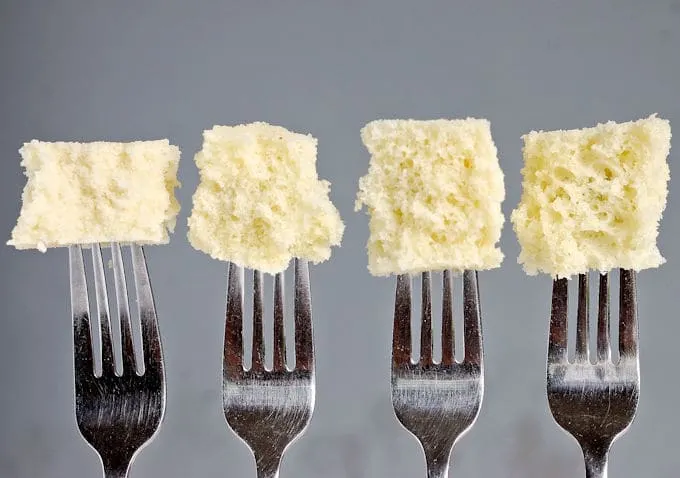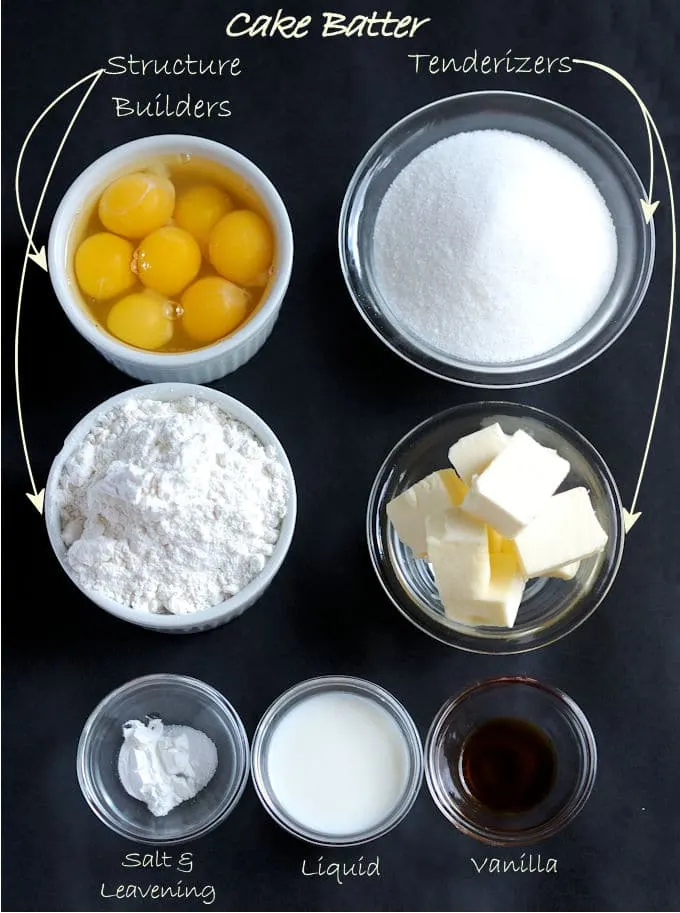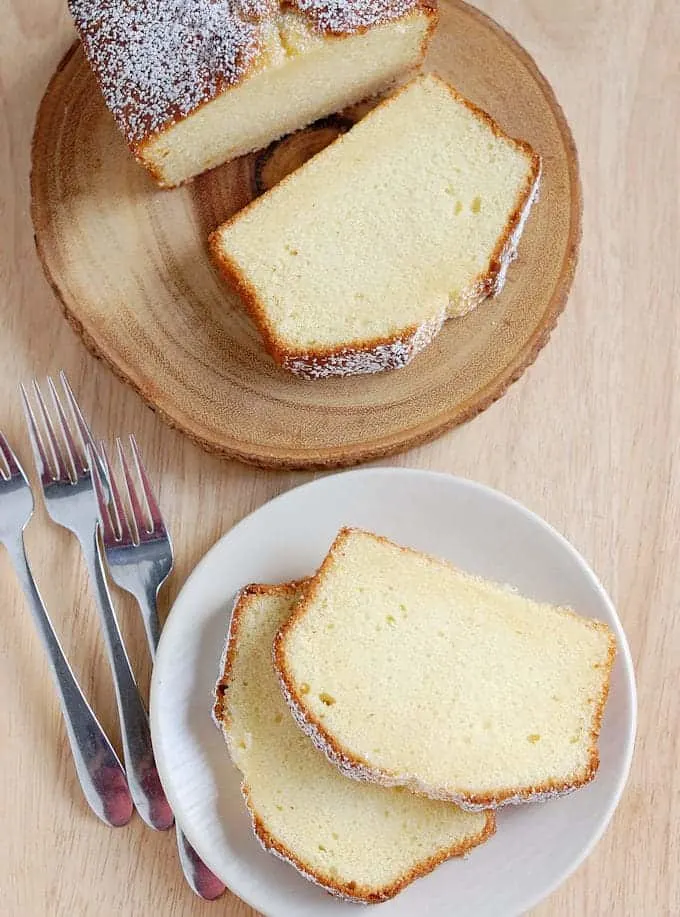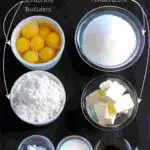How to create the best Cake Recipes
In this article we’ll learn how to create a great cake recipe using the Baker’s Formula.
The information in this article is the culmination of all our Cake Batter classes, but can also stand alone. If you’d like to follow the classes in order visit the Baking School/Science of Cake Batter page.

Use the Baker’s Formula for making the best cakes
To make a perfectly moist and soft cake you’ll first need to understand the concept of the baker’s formula.
A successful cake recipe balances the ingredients that strengthen the cake structure (flour and eggs) with the ingredients that weaken and tenderize the cake structure (sugar and fat).
The Baker’s Formula is used to calculate the proper percentage of each ingredient for a successful recipe. The flour in the recipe is designated at 100% and all the other ingredients are designated relative to the flour. This is a very important point, so keep it in mind as we get deeper into it.

Lean Cakes vs. High Ratio Cakes
About Lean Cakes:
A pound cake recipe made with equal weights of flour, sugar, butter and eggs is a so-called “lean cake”. A “lean cake” has a very simple 1:1 formula balancing the structure-builders with the tenderizers.
The only liquid in the original recipe comes from the eggs (egg whites are 90% water).
About High Ratio Cakes:
While a lean cake is made with equal proportions of flour and sugar, a high ratio cake has a higher proportion of sugar to flour.
In order for a high ratio cake to have good structure we need to adjust some of the other ingredients to keep the cake formula balanced.
Liquid brings together the structure builders and the tenderizers in the batter. The liquid activates the gluten and swells the starch in the flour. The liquid also dissolves the sugar and helps disperse the fat throughout the batter and, of course, provides moisture.
If we use cake flour, with it’s finely ground starch that absorbs extra moisture, we can change the Baker’s Formula to allow for more liquid.
We can also use an emulsifier in the batter to help bind the liquid and fat in the batter. This allows for even more liquid in the recipe, and thus more sugar since you need liquid to dissolve sugar.
A cake made with cake flour and an emulsifying agent can now be higher than 1:1 (sugar:flour) without compromising the structure.

Adjust the Baker’s Percentages for A Better Pound Cake
I used the original quatre quarts pound cake recipe as the basis for all the cake batter classes because the simple 1:1:1:1 ratio makes it very easy to measure changes. So that is the recipe I will use to show you how to use the baker’s formula to improve a cake recipe.
The first step was to lighten the crumb a tiny bit, so I added a little baking powder to the recipe. A pinch of salt and a teaspoon of real vanilla extract were added to enhance the flavor.
Now that the cake was lighter I wanted to sweeten things up a bit. The Baker’s Formula for a high ratio cake allows for up to about 140% of the weight of sugar to flour. I found in my testing that I like pound cake with a ratio of 125% sugar to 100% flour. With this in mind I increased the sugar in the recipe from 8 oz to 10 oz.
I also wanted to add a little extra liquid for moistness, so I needed an emulsifier in the batter. Vegetable shortening will act as an emulsifier, but I prefer an all-butter cake for the unparalleled flavor.
Instead of using shortening in the batter, I used a few extra egg yolks because yolks are great emulsifiers and also add a little extra fat and flavor to the batter. I changed the 8 oz of eggs in the recipe to 3 whole eggs and 4 extra yolks.
Now that we have cake flour and emulsifying eggs yolks in the recipe we can add a little more liquid for additional moisture. I added whole milk as the liquid for a basic pound cake recipe.
The revised recipe makes the perfect melt-in-your-mouth buttery pound cake.
Adjust Baker’s Formula for A Lighter Vanilla Layer Cake
Of course the Baker’s Formula is not only useful for perfecting pound cake recipes. We can continue to test the limits of the structure builders and tenderizers to create a whole world of cake recipes.
I’ll give you another example. As I said, the perfect pound cake should have a dense, buttery texture that doesn’t need any icing at all. But a Vanilla Layer Cake is meant to be filled and iced with frosting. So a great Vanilla Layer Cake should be a little lighter and softer than a pound cake.
As a comparison, let’s look at the Baker’s Percentages for my Pound Cake Recipe vs. my Vanilla Butter Cake Recipe:
| Pound Cake | ||
| Flour | -8 oz | 100% |
| Fat | -9 oz | 112% |
| Sugar | -10 oz | 125% |
| Eggs | -8 oz | 106% |
| Liquid | -7.5 oz (w/eggs) |
| Vanilla Cake | ||
| Flour | -9 oz | 100% |
| Fat | -10.6 oz | 116% |
| Sugar | -12 oz | 133% |
| Eggs | -6.6 oz | 73% |
| Liqui | -12 oz (w/eggs) |
Ok, that’s a lot of information. But lets look at the percentages. (Remember: all percentages are relative to the weight of flour in the recipe.)
By just looking at the percentages you can guess that the vanilla cake will be a little more tender (more sugar and fat), a little sweeter (more sugar) and a little more moist (more liquid) than the pound cake.
The vanilla cake recipe also has more leavening and I whip the whites before adding them to the batter. So the vanilla cake also has a more open and light crumb than the pound cake.
Whew!!! So, all those small changes to the basic formula created a lighter, sweeter and softer cake. That’s just what I want for a cake that will be filled and iced with buttercream.
The takeaway here is that every cake recipe in the universe is some variation on this formula. The type of fat or liquid can change, additional ingredients can be added, but it’s always about the balance between structure and softness.
It’s the variations that create the myriad of cake recipes that we can invent and perfect.


Hi, came across your blog whilst doing some research for a baking class.
My query/issue is how to work out what size pan can be used as an alternative. Or if i am making my own recipe how do i figure out what size pan i would need?
Apologies for asking a dumb question, but ive been paasionate about baking but uptill now i have only followed recipes and never had the confidence to make my own up. Now i am teaching baking to a few freinds i am really keen to learn more.
Thank you so much for you time and patience
HICE EL PASTEL DE VAINILLA Y SALIO MUY DENSO, MUY APELMASADO, TARDO MUCHO HORNEANDOSE, EN VERDAD SABIA BIEN PERO PARECIA UN PUDIN
I ran this comment through a translator and it seems you had trouble with the vanilla cake. It’s hard from your comment to know how to help. Sorry.
Hi Eileen,
What role does sour cream play in the recipe?
Can I substitute sour cream with whole milk/ coconut milk ?
Thank you.
Hi Emma, Sour cream has fat and liquid. Yes you can replace the sour cream with whole milk, coconut milk or buttermilk. I just adapted my vanilla cake recipe to a spice cake and switched out the sour cream and used buttermilk with good results. Milk will have a little more liquid than sour cream, but this recipe can handle a little more liquid.
Hi Eileen,
I have always love to learn the fundamental of baking, esp cakes & tarts. This blog is just exactly what I have been looking for.
Much respect & appreciation on your years of experiment to share these knowledge for everyone.
Cheers.
Thanks!
HI there.
Thank you for writing such an informative article!
I’m a bit confused with your egg weights in the formula’s vs the recipes.
You mention in the vanilla butter cake (high ratio) recipe, that the eggs are 9oz in the percentage breakdown.
But I keep doing the math, and I always come up short.
6 egg yolks (roughly 0.6oz each) is 3.6oz.
3 large egg whites (roughly 1oz each), is 3oz.
so 6.6oz? I’m confused where the 9oz comes from.
In the pound cake breakdown, you mention the liquids are 6oz, but the eggs are 8oz? But the liquids contain the eggs, so how are the liquids less than the eggs?
I’m just a bit confused,
Thanks for your help!!
Hi Junior. Actually, the 9 oz weight for the eggs in the vanilla cake was a typo. Thanks for catching it! I think I must’ve either copied it from the pound cake list or mistakenly counted the 6 yolks as whole eggs. I’ve edited the list.
As far as the liquid — The reason there is less liquid than eggs is because the eggs are not all water. They also have fat, protein, etc. Whole eggs are about 75% water, whites are about 87% water and yolks are about 50% water. So the 3 whole eggs (5.19 oz total weight) would have about 4.5 oz water in them (5.19 oz x .75 = 4.5oz). The 4 yolks have a total of 1 oz. So 4.5oz + 1.5oz = 6 oz total liquid in the eggs. There’s also some water in the milk for a total of about 7.5 oz liquid in the entire recipe (I updated that number too).
Thanks!
Thank you Eileen, I will check this out!